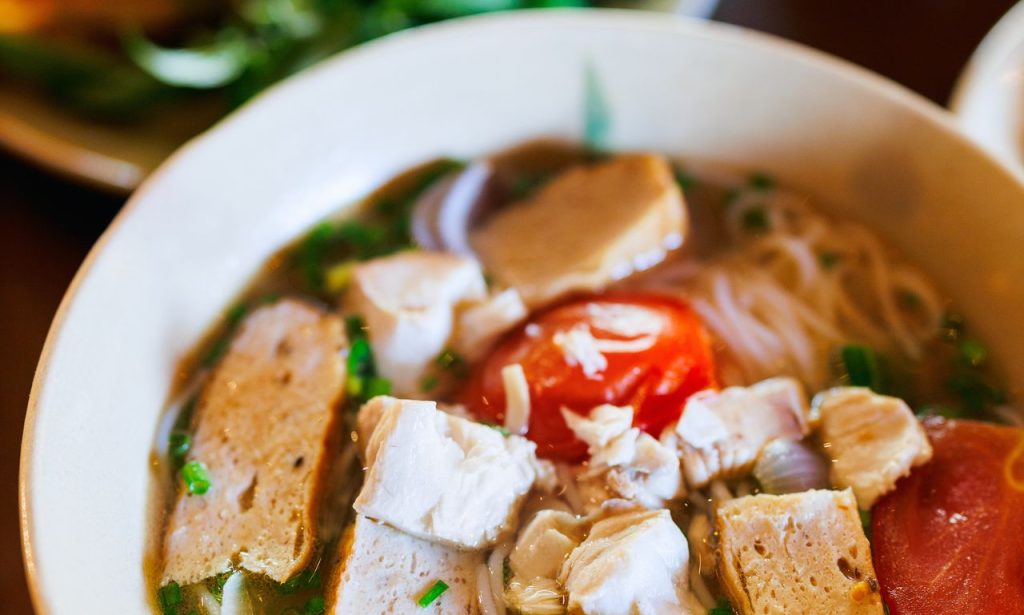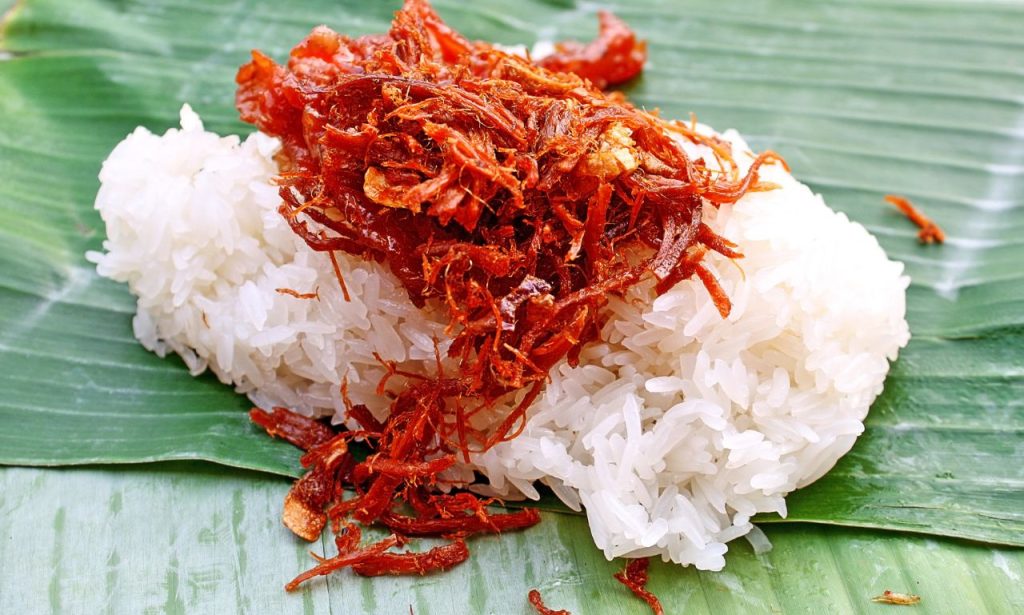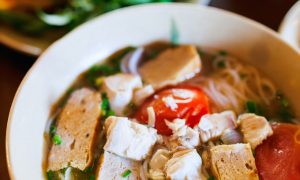Are you having a Vietnamese visitor come to stay? You may want to know what foods will make them feel at home while introducing them to your local cuisine. Vietnamese cuisine is incredibly diverse, with regional specialties from the northern mountains to the southern Mekong Delta. The food is known for its fresh ingredients, aromatic herbs, and perfect balance of flavors – sweet, sour, salty, and spicy- dancing harmoniously.
In this guide, I’ll explain some of the most beloved Vietnamese dishes, their regional origins, and how you might prepare or source them for your visitor.
Pho
Pho (pronounced “fuh”) is perhaps Vietnam’s most famous culinary export and a dish your visitor will likely miss from home. This aromatic noodle soup typically features a rich beef broth, rice noodles, thinly sliced meat, and a basket of fresh herbs and bean sprouts on the side.
Regional variations exist throughout Vietnam:
- Northern-style pho (from Hanoi) tends to have a clearer broth with fewer garnishes
- Southern-style pho (from Ho Chi Minh City) often has a sweeter broth with more herbs and accompaniments
If you plan to make pho at home, be prepared for a long-simmering process – authentic broth often cooks for 6-8 hours with beef bones and aromatic spices like star anise, cinnamon, and cloves. The magic happens when your visitor customizes their bowl with lime, chili, herbs, and bean sprouts.
Many cities now have authentic Vietnamese restaurants serving proper pho. Ask your visitors which style they prefer, as regional loyalties to pho can run deep!
Nha Trang
Nha Trang is a coastal city in central Vietnam known for its stunning beaches and incredible seafood. If your Vietnamese visitors are from this region, they might appreciate dishes featuring fresh seafood prepared but flavorfully.
Some Nha Trang specialties include:
Bún Cá (Fish Noodle Soup)

This refreshing dish features a light, clear broth with rice noodles and chunks of white fish. It’s often served with a basket of fresh herbs, lime wedges, and chili to add according to taste. The broth is usually made with fish bones and flavored with pineapple for a subtle sweetness.
If your visitor is from Nha Trang, finding a good bún cá might bring back fond memories of home. Many coastal Vietnamese restaurants will offer this dish, often with a regional twist.
Goi Cuon
Goi cuon, or what is most commonly called fresh spring rolls or summer rolls in English, is a light and refreshing appetizer that your Vietnamese visitor is bound to be familiar with. As opposed to their fried counterpart, these rolls are wrapped in transparent rice paper and filled with fresh herbs, rice noodles, and protein (most commonly shrimp and pork). What makes goi cuon stand out is its lightness and the vibrant flavors of fresh mint, cilantro, and sometimes Thai basil. They are often served with a creamy peanut dipping sauce or a fish sauce-based dip called nuoc cham.
Hue
Hue was Vietnam’s imperial capital, and its cuisine reflects its royal heritage. If your visitors are from central Vietnam, they might have a special appreciation for Hue’s distinctive flavors, which are spicier and more complex than other regional cuisines.
Bún Bò Huế (Spicy Beef Noodle Soup)
This traditional dish has round rice noodles in a red-hued lemongrass-beef broth. The traditional versions have beef shank, pork knuckles, and pig’s blood cubes that are hardened. The broth is full-bodied, and the lemongrass, shrimp paste, and chili in the broth are perfectly balanced. The dish is usually served with bean sprouts, shredded banana blossoms, lime wedges, and herbs. If your visitor is from Hue, finding a genuine bún bò Huế can be a treat. Most Vietnamese restaurants serve this dish, although the spiciness is typically muted for local tastes.
Banh Xeo
Banh xeo, or Vietnamese sizzling crepes, are crispy, savory pancakes made from rice flour and turmeric (giving them their distinctive yellow color). They’re filled with pork, shrimp, bean sprouts, and mung beans, then folded in half like a crepe. The name “banh xeo” comes from the sizzling sound (xeo) the batter makes when it hits the hot pan. These crepes are meant to be eaten by breaking off pieces, wrapping them in lettuce leaves and herbs, and dipping in nuoc cham sauce.
Regional variations exist throughout Vietnam:
- Southern-style banh xeo tends to be larger and crispier
- Central Vietnamese versions are often smaller and thicker
Bun Cha
Bun cha gained international fame when Anthony Bourdain took President Obama to try it in Hanoi, but it’s been a beloved lunch dish in northern Vietnam for generations. It consists of grilled pork patties and slices of fatty pork served in a sweet-savory broth with rice noodles and fresh herbs. The dish is typically served with nem cua be (fried spring rolls) and a basket of herbs, including perilla, mint, and coriander. Combining smoky grilled meat, refreshing herbs, and tangy dipping sauce creates a perfect balance of flavors.
Cao Lầu
Cao lầu is a noodle dish unique to Hoi An in central Vietnam. It features thick, chewy rice noodles that are said to be made with water from a specific well in Hoi An. The noodles are tossed with pork slices, crispy croutons, bean sprouts, and fresh herbs.
What makes cao lầu special is the noodles themselves – they have a unique texture and color due to being mixed with ash from a specific type of tree. The dish is barely sauced, lightly seasoned with broth, and served with local greens.
This dish might be harder to find outside Vietnam, but if your visitor is from Hoi An, they might appreciate your knowledge of this regional specialty. Some specialized Vietnamese restaurants might offer their interpretation of cao lầu.
Xôi
Xôi (sticky rice) is a versatile dish that can be served as a main course, side dish, or dessert. It’s a staple in Vietnamese cuisine and comes in countless variations:
Xôi Mặn (Savory Sticky Rice)
This hearty dish features sticky rice topped with a combination of Chinese sausage, shredded chicken, dried shrimp, fried shallots, and sometimes a fried egg. It’s often eaten for breakfast or as a quick meal throughout the day.
Xôi Ngọt (Sweet Sticky Rice)

Sweet versions of xôi are popular desserts or snacks. They might be colored with natural ingredients like pandan leaf (green) or mung beans (yellow) and sweetened with sugar or coconut milk. Sticky rice is fairly easy to find in most cities with Asian markets. If your visitor is missing a taste of home, preparing a simple xôi dish might be a welcome comfort food.
Hủ Tiếu Nam Vang
“Nam Vang” refers to Phnom Penh, reflecting the dish’s Cambodian influence. This soup features clear pork bone broth with rice noodles and a variety of toppings, including pork, seafood, quail eggs, and fresh herbs. The slightly sweet broth and the variety of textures from the different ingredients make it distinctive. The dish can be served “dry” (with broth on the side) or “wet” (with noodles in the broth). If your visitors are from southern Vietnam, they might appreciate finding this regional specialty at a Vietnamese restaurant.
Bún Bò Cuốn Lá Lốt
Bún bò cuốn lá lốt features seasoned beef wrapped in aromatic betel leaves and grilled to perfection. The betel leaves impart a unique flavor that’s slightly peppery and herbaceous. These flavorful beef rolls are typically served with rice noodles, fresh herbs, and a dipping sauce. The dish is interactive—you wrap the beef rolls with noodles and herbs in lettuce leaves before dipping.
This dish might be harder to find outside Vietnam, but specialized Vietnamese restaurants might offer it. If your visitors are familiar with this dish, they might be impressed by your knowledge of Vietnamese cuisine beyond the basics.
Conclusion
Having a guest from Vietnam is a wonderful opportunity to uncover the rich ethnic richness of Vietnamese food. To cook at home or to find genuine restaurants, showing interest in your visitor’s food culture will be appreciated. Understand that Vietnamese food is immensely diverse by locale, so requesting your guests for their personal household dishes will guide your food choices. Don’t hesitate to invite them to cook with you—most Vietnamese take pride in their cooking heritage and may enjoy the chance to show you.
ALSO READ: What to Eat After Periodontal Surgery
FAQs
Fish sauce (nuoc mam) is arguably the most essential ingredient in Vietnamese cuisine. It’s used as a cooking ingredient and a dipping sauce base, adding umami depth to dishes.
Vietnamese coffee is made using a small metal filter (phin) placed over a cup with sweetened condensed milk. Medium-coarse ground dark roast coffee is added to the filter, and hot water is poured to drip through slowly. Once brewing is complete, stir and serve over ice for the classic ca phe sua da.
Yes! While fish sauce is standard, many Vietnamese dishes can be adapted for vegetarians. Look for dishes with “chay” in the name, which indicates vegetarian versions. Buddhist temple cuisine in Vietnam is entirely vegetarian and features creative meat substitutes.
Northern Vietnamese cuisine tends to be simpler, less sweet, and less spicy than Southern cuisine. Southern dishes often feature more herbs, sugar, and chili. Central Vietnamese cuisine is typically the spiciest of all regions.
No, visitors to Vietnam should stick to bottled water. Locals typically boil tap water before drinking it. Ice from reputable restaurants is usually made with purified water and is generally safe.




